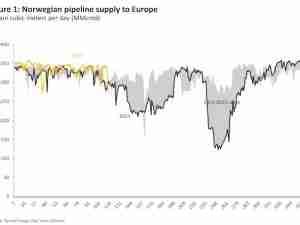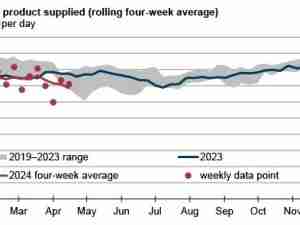Europe’s power markets enjoy a lull as warmer weather reduces demand and prices. But in the east, the energy crisis takes on a new dimension as Ukraine’s electricity sector is knocked by Russian attacks on key infrastructure.
Here is Rystad Energy’s weekly power market note from Senior Analyst Fabian Rønningen:
Europe
European power prices continued to decline last week on the back of mild weather across the continent and a further fall in gas prices.
France saw an especially large fall last week of 33.6%, while German prices were also appreciably down.
The average for the week was €149 ($146) per megawatt-hour (MWh), the lowest level since week 7 in February, and the second-lowest week so far in 2022.
Italy also saw a very large decline last week due to a significant fall in gas prices, which is covered later in this note.
This resulted in the country recording its lowest weekly average prices so far this year, which few would have expected just a couple of weeks ago, averaging €181 per MWh for the week
The gap between German and UK prices widened slightly last week, averaging €149 and €116 per MWh, respectively, on the back of slightly better wind conditions in the UK compared to Germany.
The UK has now seen the overall largest decrease in power prices since the peak in late August, with an 81% fall.
The remaining Continental European markets, as well as the Nordic system price, have all seen a reduction of above 70%, with Spain being the only exception.
New green hydrogen pipeline announced
Plans for the MidCat pipeline project from Iberia to Central Europe has been scrapped, it was announced last week by Spanish, Portuguese and French leaders.
France has been opposed to the project, stating environmental and economical concerns.
The project will be replaced by a new “green energy corridor” subsea pipeline connecting Barcelona in Spain and Marseille in France, intended for green hydrogen transportation, although it could be used for temporary gas transport if required.
New dimension to the energy crisis as Ukraine electricity sector gets hit
The energy crisis takes on a new dimension as Ukraine’s electricity sector is knocked by Russian attacks on key infrastructure.
Russian attacks on Ukraine's energy infrastructure have increased in recent weeks and as many as 1.5 million households are without power.
There have been more attacks on the Ukrainian energy system since 10. October than in the eight previous months combined, as this has been a specific target for Russia.
This could pose a major challenge going forward as the winter approaches.

For the coming week, prices are expected to stay more or less in the same range as last week, but with the potential for further decline.
There remains a good chance of a further decline in gas prices as storage levels have reached even higher levels in Europe over the last week, temperatures are expected to stay above normal and wind speeds are expected around average for the year, and above normal in the UK.
The gas market continues to be the main driver for reduced power prices, in addition to soft demand fundamentals and solid renewables generation in recent weeks.
The Dutch Title Transfer Facility (TTF) spot contract closed as low as €51 per MWh on 21 October, a 16.1% reduction since the beginning of the week.
That is a new record low for the year so far and a 41% reduction year-to-date, while it is also a massive 85% reduction since the peak in late August.
In the futures market, the TTF saw declines on all contracts last week, and the front-month saw an 11.6% decline, closing the week at €114.9 per MWh.
A gap has now opened up between front-month and longer-term futures, as gas for short-term delivery is traded at a discount.
The same fundamentals that are weighing down the spot price are affecting the front-month as well and to a much lower extent long-term gas contracts.
The front-month fell again on the morning of 24 October, posting a near 10% decline to €104 per MWh.
<image003.png>
Total European underground storage is beginning to flatten out but is still increasing overall. Storage levels reached 92.8% across Europe on 21 October, the highest level since November 2020.
Liquefied natural gas (LNG) imports continued to be very strong in October as well, with high utilization across European LNG regasification terminals.
So far in October, France is leading Spain and the UK as the largest LNG importer in Europe.
Coal
The coal market has also seen a solid decline in prices in recent weeks, with the API2 front-month benchmark for European hard coal prices seeing a drop of 34% since the beginning of September on front-month contracts.
The contract closed at $258 per tonne last week, and the front-year is trading in the same range.
One factor behind the decline in global coal prices has been the large increase in mainland China’s domestic coal production, reducing Chinese imports and freeing up more supply to other regions.
Germany could return as much as 7 additional gigawatts (GW) of lignite and hard coal capacity for the winter to alleviate some of the pressure in the power market for the coming winter.
The move is expected to save up to 30 terawatt-hours (TWh) of gas in the power sector, according to European energy market information provider Montel News.
The operators expected to bring back most of the capacity are Steag with 2.3 GW of hard coal capacity and RWE with 2.1 GW of lignite.
The extra capacity will be taken from plants currently in reserve.
In addition to freshly announced plans to keep all three remaining nuclear units in Germany operational until April 2023, this is expected to add some relief to markets for the coming winter.
Germany was the second-largest power exporter in Europe for the first three quarters, behind only Sweden, caused by, among other factors, the large shortfall in French nuclear power generation.
French nuclear
Weeks of strikes at french nuclear power plants are over as a draft agreement was reached on 21 October.
The strikes caused major delays to maintenance at several French nuclear reactors and availability was as low as 45% last week across the fleet.
This could be another bearish driver for prices going forward as more reactors could return to operation sooner than otherwise expected.










